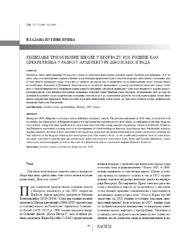Приказ основних података о документу
Podizanje tri osnovne škole u Beogradu 1928. godine kao prekretnica u razvoju arhitekture školskih zgrada
The construction of three elementary schools in Belgrade in 1928 as a turning point in the development of school building architecture
| dc.creator | Putnik Prica, Vladana | |
| dc.date.accessioned | 2021-10-12T12:43:01Z | |
| dc.date.available | 2021-10-12T12:43:01Z | |
| dc.date.issued | 2018 | |
| dc.identifier.issn | 1450-605X | |
| dc.identifier.uri | http://reff.f.bg.ac.rs/handle/123456789/2539 | |
| dc.description.abstract | Beograd je tokom treće decenije XX veka bio suočen sa ozbiljnim nedostatkom osnovnih škola. Problem je kulminirao 1928. godine, kada je na inicijativu građana opština grada Beograda projektovala dve i pomogla izgradnju treće škole u naseljima koja su tada činila periferiju grada. Osim što su značajne kao škole koje su podignute posle višegodišnje pauze, o snovne škole na Bulbulderu, Voždovcu i Dušanovcu predstavljale su svojevrsnu prekretnicu u razvoju arhitekture školskih zgrada. Osim što su bile funkcionalne i higijenski zadovoljavajuće građevine, tri škole prikazane u ovom radu najavile su i dalji razvoj u izgradnji škola, tako inicirajući konačno donošenje Razvojnog plana Opštine grada Beograda. Istraživanje ovog do sada nedovoljno istraženog polja graditeljskih ostvarenja omogućilo je i da se detaljnije rasvetli uloga istoriografiji gotovo nepoznatih opštinskih arhitekata Žarka Krstića i Desanke Manojlović, ali i pojava, do sada malo poznatog autora, građevinskog inženjera Radoslava Todorovića. | sr |
| dc.description.abstract | During the 1930s, Belgrade was facing a serious deficiency of primary schools. The problem culminated in 1928 when, at the initiative of its citizens, the Municipality of Belgrade designed two and helped the construction of a third school, in settlements at the time being the city outskirts. Along with their significance as schools that were built after a long standstill, the primary schools in Bulbulder, Voždovac and Dušanovac represented a turning point in the development of school building architecture. In addition to their functionality and good hygiene standards, the three schools presented in this paper also announced the further advancement in school construction, initiating the final adoption of the Belgrade Municipality development plan. The research of this, so far insufficiently explored, field of construction has made it possible to shed the light and present more details about the role of architects Žarko Krstić and Desanka Manojlović, nearly unknown to the historiography, as well as the work of a little-known author, construction engineer Radoslav Todorović. | en |
| dc.publisher | Zavod za zaštitu spomenika kulture grada Beograda, Beograd | |
| dc.rights | openAccess | |
| dc.rights.uri | https://creativecommons.org/licenses/by/4.0/ | |
| dc.source | Nasleđe | |
| dc.subject | osnovne škole | sr |
| dc.subject | Beograd | sr |
| dc.subject | arhitektura | sr |
| dc.subject | 1928. godina | sr |
| dc.subject | year 1928 | en |
| dc.subject | primary schools | en |
| dc.subject | Belgrade | en |
| dc.subject | architecture | en |
| dc.title | Podizanje tri osnovne škole u Beogradu 1928. godine kao prekretnica u razvoju arhitekture školskih zgrada | sr |
| dc.title | The construction of three elementary schools in Belgrade in 1928 as a turning point in the development of school building architecture | en |
| dc.type | article | |
| dc.rights.license | BY | |
| dc.citation.epage | 77 | |
| dc.citation.issue | 19 | |
| dc.citation.other | (19): 67-77 | |
| dc.citation.rank | M52 | |
| dc.citation.spage | 67 | |
| dc.identifier.doi | 10.5937/nasledje1819067P | |
| dc.identifier.fulltext | http://reff.f.bg.ac.rs/bitstream/id/1260/2536.pdf | |
| dc.type.version | publishedVersion |

